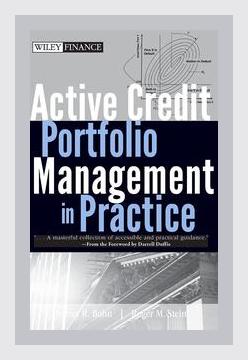Finance and AccountingRisk Management
**
Introduction
“Active Credit Portfolio Management in Practice” by Jeffrey R. Bohn and Roger M. Stein is an authoritative resource in the realm of risk management, focusing on advanced strategies and practical applications for managing credit risks. The authors draw on their extensive experience in the industry to provide readers with a comprehensive guide to optimizing credit portfolios. The book is particularly invaluable for financial professionals looking to enhance their understanding of credit risk strategies and applications.
Chapter 1: Introduction to Active Credit Portfolio Management
Major Points and Actions:
- Definition and Goals
- Active Credit Portfolio Management (ACPM) aims to dynamically adjust credit portfolios in response to changing market conditions to optimize performance and mitigate risks.
-
Action: Financial managers should regularly review and adjust their credit portfolios based on market movement and predictions to stay ahead of potential risks.
-
Conceptual Framework
- The book lays a conceptual foundation for ACPM, emphasizing the importance of an integrated approach that combines quantitative methods with expert judgment.
- Example: Combining metrics such as Value at Risk (VaR) with scenario analysis to gauge credit exposure under various conditions.
- Action: Implement a dual approach of quantitative modeling and expert insights for a holistic assessment of credit risks.
Chapter 2: Quantitative Tools and Techniques
Major Points and Actions:
- Credit Risk Models
- The authors discuss the importance of models such as the Merton model, which relates the firm’s equity value to its credit risk.
- Example: Using the Merton model to estimate default probabilities.
-
Action: Apply the Merton model in assessing the default risk of corporate bonds within the portfolio.
-
Credit Migration and Rating Transition Matrices
- The book elaborates on the use of credit migration matrices to predict changes in credit quality.
- Example: Tracking historical rating transitions to predict future movements in credit ratings.
- Action: Incorporate rating transition matrices into the portfolio management process to anticipate and manage changes in credit quality.
Chapter 3: Portfolio Optimization Techniques
Major Points and Actions:
- Mean-Variance Optimization
- Bohn and Stein adapt traditional mean-variance optimization techniques to credit portfolios, focusing on balancing return and risk.
- Example: Using historical credit returns and variances to construct an optimized portfolio.
-
Action: Employ mean-variance optimization to design credit portfolios that align with the risk-return profiles of institutional investors.
-
Credit Risk Diversification
- They emphasize the importance of diversification in reducing idiosyncratic risk.
- Example: A diversified credit portfolio spread across multiple industries and geographies.
- Action: Consistently review and diversify exposure across different sectors and regions to minimize localized risks.
Chapter 4: Measuring and Managing Credit Risk
Major Points and Actions:
- Credit Value at Risk (Credit VaR)
- The book provides in-depth coverage of Credit VaR, a key metric in gauging potential credit losses.
- Example: Calculating Credit VaR using historical data and Monte Carlo simulations.
-
Action: Integrate Credit VaR computations into regular risk reports to monitor potential losses and adjust strategies accordingly.
-
Counterparty Risk Assessment
- Bohn and Stein discuss assessing the creditworthiness of counterparties to mitigate counterparty risk.
- Example: Using credit default swap (CDS) spreads as an indicator of counterparty risk.
- Action: Evaluate CDS spreads regularly to gauge changes in the creditworthiness of counterparties and act swiftly if a significant increase is detected.
Chapter 5: Tools for Active Management
Major Points and Actions:
- Hedging Strategies
- The authors outline various hedging strategies, including the use of credit derivatives to manage exposure.
- Example: Utilizing credit default swaps (CDS) to hedge against potential defaults.
-
Action: Incorporate CDS and other credit derivatives into hedge strategies to protect the portfolio from adverse credit events.
-
Credit Portfolio Trading
- Emphasis is placed on the active trading of credit assets to exploit market mispricings.
- Example: Selling overvalued bonds and purchasing undervalued ones based on credit spread analysis.
- Action: Regularly conduct market analysis to identify and act upon opportunities to trade credit assets for profit.
Chapter 6: Case Studies in Active Credit Portfolio Management
Major Points and Actions:
- Real-world Applications
- The book includes detailed case studies illustrating successful ACPM implementations.
- Example: A financial institution improving its risk profile through active rebalancing of its credit portfolio during an economic downturn.
-
Action: Analyze real-world case studies to draw practical lessons and apply similar strategies to one’s credit portfolio management practices.
-
Lessons Learned
- Key lessons from the case studies indicate the value of flexibility and responsiveness.
- Example: A fund manager avoiding substantial losses by quickly adjusting credit exposures in response to early warning signals.
- Action: Build and maintain a flexible portfolio management framework that allows rapid adjustments in response to market signals.
Chapter 7: Regulatory and Reporting Considerations
Major Points and Actions:
- Compliance with Basel II/III
- The authors discuss the importance of adhering to regulatory frameworks such as Basel II and III.
- Example: Implementing required capital adequacy ratios and risk-weighted asset calculations.
-
Action: Ensure that all portfolio management practices comply with current regulatory requirements and are prepared for evolving standards.
-
Transparency in Reporting
- Emphasizing the need for clear and transparent risk reporting to stakeholders.
- Example: Generating regular reports that detail risk exposures, mitigation strategies, and performance metrics.
- Action: Develop a robust reporting system that provides stakeholders with clear insights into the credit portfolio’s risk and performance dynamics.
Conclusion
“Active Credit Portfolio Management in Practice” by Jeffrey R. Bohn and Roger M. Stein stands as a comprehensive guide for managing credit portfolios in a dynamic and strategic manner. Its integration of quantitative models with practical insights provides financial professionals with the tools needed to navigate complex credit markets. By applying the principles and actions derived from the book, credit portfolio managers can better optimize their portfolios, mitigate risks, and enhance overall performance.
